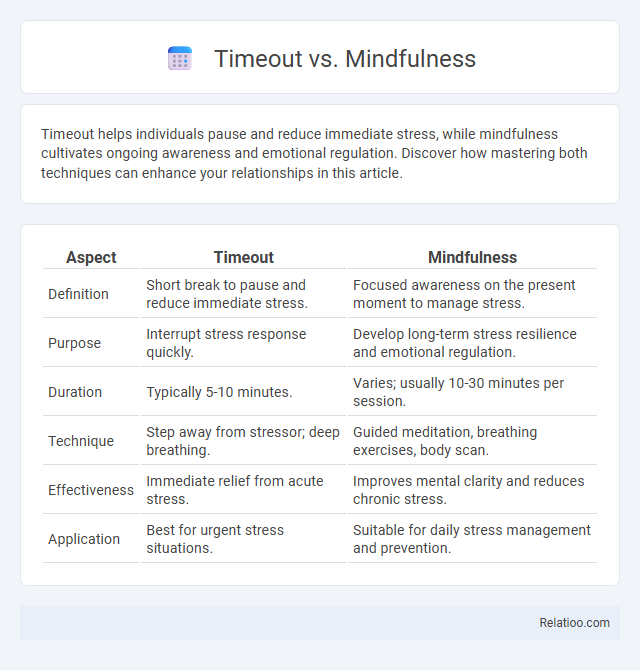Timeout helps individuals pause and reduce immediate stress, while mindfulness cultivates ongoing awareness and emotional regulation. Discover how mastering both techniques can enhance your relationships in this article.
Table of Comparison
| Aspect | Timeout | Mindfulness |
|---|---|---|
| Definition | Short break to pause and reduce immediate stress. | Focused awareness on the present moment to manage stress. |
| Purpose | Interrupt stress response quickly. | Develop long-term stress resilience and emotional regulation. |
| Duration | Typically 5-10 minutes. | Varies; usually 10-30 minutes per session. |
| Technique | Step away from stressor; deep breathing. | Guided meditation, breathing exercises, body scan. |
| Effectiveness | Immediate relief from acute stress. | Improves mental clarity and reduces chronic stress. |
| Application | Best for urgent stress situations. | Suitable for daily stress management and prevention. |
Understanding Timeout: Definition and Purpose
Timeout is a behavioral strategy used to temporarily remove an individual from a reinforcing environment to decrease unwanted behaviors by providing a calm period. Mindfulness emphasizes present-moment awareness and non-judgmental observation, promoting emotional regulation without avoidance. Understanding Timeout involves recognizing its purpose as a structured break designed to reduce stimuli and help individuals regain self-control.
The Core Principles of Mindfulness
The core principles of mindfulness revolve around present-moment awareness, non-judgmental observation, and acceptance of thoughts and emotions without reactivity. Unlike a timeout, which serves as a pause to cool down or disrupt negative behavior, mindfulness engages intentional attention and cultivates inner calm through breathing and sensory awareness practices. Mindfulness fosters emotional regulation and resilience by promoting self-awareness, whereas timeouts are typically external interventions aimed at behavioral correction.
Psychological Impacts: Timeout vs Mindfulness
Timeouts provide immediate behavioral regulation by temporarily removing individuals from stressors, reducing impulsive reactions and allowing emotional cooling. Mindfulness enhances long-term psychological resilience through increased self-awareness, emotional regulation, and reduced anxiety by fostering present-moment focus and non-judgmental acceptance. Comparing both, timeouts offer quick, situational relief, while mindfulness cultivates sustained mental well-being and adaptive coping strategies over time.
Timeout in Parenting and Education
Timeout in parenting and education serves as a powerful behavior management tool that allows children to pause and reflect on their actions, reducing immediate emotional reactions. Unlike mindfulness, which encourages present-moment awareness and emotional regulation, timeout provides a structured break aimed at promoting discipline and self-control. Your effective use of timeout can help establish clear boundaries and improve your child's ability to manage impulses and develop healthy coping mechanisms.
Mindfulness Techniques for Emotional Regulation
Mindfulness techniques enhance emotional regulation by promoting present-moment awareness and non-judgmental acceptance of feelings, which reduces impulsive reactions and stress. Unlike timeouts that serve as immediate behavioral breaks, mindfulness fosters long-term emotional resilience through practices like deep breathing, body scans, and meditation. Integrating mindfulness into emotional regulation strategies supports sustained mental clarity and improved self-control in challenging situations.
Comparing Short-Term and Long-Term Outcomes
Timeout strategies often yield immediate behavioral improvements by providing a break from triggers, promoting short-term emotional regulation. Mindfulness practices foster sustained self-awareness and stress reduction, leading to long-term psychological resilience and improved decision-making. Combining timeout with mindfulness can enhance both immediate coping mechanisms and lasting emotional well-being, optimizing overall mental health outcomes.
Effectiveness in Behavior Management
Timeout is an effective behavior management technique that temporarily removes a child from a reinforcing environment to decrease undesirable behaviors, supported by numerous empirical studies demonstrating reduced aggression and noncompliance. Mindfulness enhances self-regulation and emotional awareness, promoting long-term behavior change by increasing a child's ability to recognize and manage impulses, as evidenced in improved emotional control and reduced anxiety. Comparative research suggests combining timeout with mindfulness interventions yields superior outcomes in behavior modification by addressing both immediate behavior suppression and long-term emotional resilience.
Fostering Self-Awareness: Mindfulness vs Timeout
Mindfulness fosters self-awareness by encouraging present-moment observation of thoughts and emotions, helping individuals understand their internal experiences deeply. Timeout, in contrast, provides physical or mental space away from stressors, allowing for emotional regulation but less direct engagement with internal states. Integrating mindfulness during timeout periods enhances self-awareness by combining reflective calmness with intentional observation of feelings.
Potential Drawbacks and Criticisms
Timeout techniques can lead to feelings of isolation and shame in children, potentially hindering emotional development when overused or improperly applied. Mindfulness practices might be criticized for requiring consistent practice and cognitive engagement, which can be challenging for young children or those with attention difficulties. While timeout focuses on behavioral correction through removal from stimuli, mindfulness emphasizes awareness and emotional regulation, but critics argue neither approach alone fully addresses underlying psychological or environmental factors influencing behavior.
Integrating Timeout and Mindfulness Practices
Integrating timeout and mindfulness practices enhances emotional regulation by providing structured moments for reflection and present-moment awareness, reducing impulsive reactions and stress. Timeout allows individuals to disengage from triggering situations, while mindfulness fosters nonjudgmental awareness and acceptance of thoughts and feelings during these pauses. Combining these strategies improves resilience, promotes self-control, and supports mental well-being through balanced cognitive and emotional processing.

Infographic: Timeout vs Mindfulness
 relatioo.com
relatioo.com